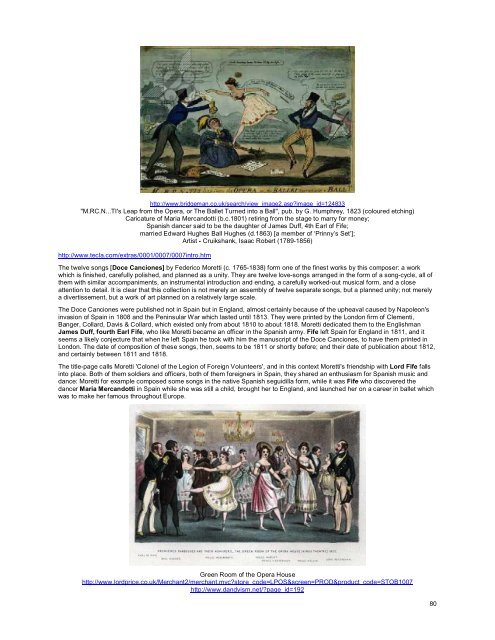Grand Masters of Scotland - Onondaga and Oswego Masonic ...
Grand Masters of Scotland - Onondaga and Oswego Masonic ...
Grand Masters of Scotland - Onondaga and Oswego Masonic ...
You also want an ePaper? Increase the reach of your titles
YUMPU automatically turns print PDFs into web optimized ePapers that Google loves.
http://www.bridgeman.co.uk/search/view_image2.asp?image_id=124833<br />
"M.RC.N...TI's Leap from the Opera, or The Ballet Turned into a Ball", pub. by G. Humphrey, 1823 (coloured etching)<br />
Caricature <strong>of</strong> Maria Merc<strong>and</strong>otti (b.c.1801) retiring from the stage to marry for money;<br />
Spanish dancer said to be the daughter <strong>of</strong> James Duff, 4th Earl <strong>of</strong> Fife;<br />
married Edward Hughes Ball Hughes (d.1863) [a member <strong>of</strong> ‘Prinny’s Set’];<br />
Artist - Cruikshank, Isaac Robert (1789-1856)<br />
http://www.tecla.com/extras/0001/0007/0007intro.htm<br />
The twelve songs [Doce Canciones] by Federico Moretti (c. 1765-1838) form one <strong>of</strong> the finest works by this composer: a work<br />
which is finished, carefully polished, <strong>and</strong> planned as a unity. They are twelve love-songs arranged in the form <strong>of</strong> a song-cycle, all <strong>of</strong><br />
them with similar accompaniments, an instrumental introduction <strong>and</strong> ending, a carefully worked-out musical form, <strong>and</strong> a close<br />
attention to detail. It is clear that this collection is not merely an assembly <strong>of</strong> twelve separate songs, but a planned unity; not merely<br />
a divertissement, but a work <strong>of</strong> art planned on a relatively large scale.<br />
The Doce Canciones were published not in Spain but in Engl<strong>and</strong>, almost certainly because <strong>of</strong> the upheaval caused by Napoleon's<br />
invasion <strong>of</strong> Spain in 1808 <strong>and</strong> the Peninsular War which lasted until 1813. They were printed by the London firm <strong>of</strong> Clementi,<br />
Banger, Collard, Davis & Collard, which existed only from about 1810 to about 1818. Moretti dedicated them to the Englishman<br />
James Duff, fourth Earl Fife, who like Moretti became an <strong>of</strong>ficer in the Spanish army. Fife left Spain for Engl<strong>and</strong> in 1811, <strong>and</strong> it<br />
seems a likely conjecture that when he left Spain he took with him the manuscript <strong>of</strong> the Doce Canciones, to have them printed in<br />
London. The date <strong>of</strong> composition <strong>of</strong> these songs, then, seems to be 1811 or shortly before; <strong>and</strong> their date <strong>of</strong> publication about 1812,<br />
<strong>and</strong> certainly between 1811 <strong>and</strong> 1818.<br />
The title-page calls Moretti 'Colonel <strong>of</strong> the Legion <strong>of</strong> Foreign Volunteers', <strong>and</strong> in this context Moretti's friendship with Lord Fife falls<br />
into place. Both <strong>of</strong> them soldiers <strong>and</strong> <strong>of</strong>ficers, both <strong>of</strong> them foreigners in Spain, they shared an enthusiasm for Spanish music <strong>and</strong><br />
dance: Moretti for example composed some songs in the native Spanish seguidilla form, while it was Fife who discovered the<br />
dancer Maria Merc<strong>and</strong>otti in Spain while she was still a child, brought her to Engl<strong>and</strong>, <strong>and</strong> launched her on a career in ballet which<br />
was to make her famous throughout Europe.<br />
Green Room <strong>of</strong> the Opera House<br />
http://www.lordprice.co.uk/Merchant2/merchant.mvc?store_code=LPOS&screen=PROD&product_code=STOB1007<br />
http://www.d<strong>and</strong>yism.net/?page_id=192<br />
80







![Richard [Nicholls] Harison / Harrison - Onondaga and Oswego ...](https://img.yumpu.com/24950065/1/190x245/richard-nicholls-harison-harrison-onondaga-and-oswego-.jpg?quality=85)
![Richard [Nicholls] Harison / Harrison - Onondaga and Oswego ...](https://img.yumpu.com/24950063/1/190x245/richard-nicholls-harison-harrison-onondaga-and-oswego-.jpg?quality=85)








